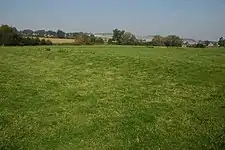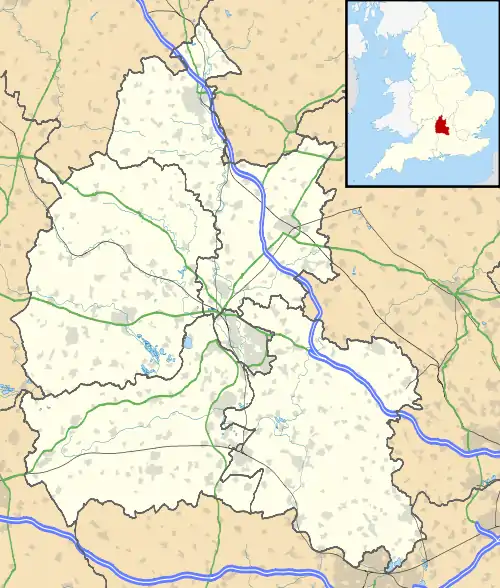Ascot d'Oilly Castle
Ascot d'Oilly Castle is situated north of the village of Ascott-under-Wychwood in the north west region of Oxfordshire. It is a scheduled ancient monument.[1] A fragment of the castle remains and is a Grade II listed building.[2] It was named after Roger d'Oilly who was granted it by William the Conqueror and whose brother built Oxford Castle. It is thought that the castle was built around 1129 and it was demolished soon after 1175. There are fragmentary remains of a stone tower. The remains consist of raised ground surrounded by broad ditching.[3]
| Ascot d'Oilly Castle | |
|---|---|
| Ascott-under-Wychwood, Oxfordshire, England | |
 Earthworks of the castle | |
 Ascot d'Oilly Castle | |
| Coordinates | 51.8697°N 1.5599°W |
| Grid reference | grid reference SP304191 |
| Site information | |
| Condition | Earthworks only |
Today the motte of the original castle survives as a mound, around 32 metres (105 ft) wide and 3 metres (9.8 ft) high. The ruins of the keep are situated on top of this mound in the central 20-metre (66 ft) area. It was excavated by Martyn Jope and R. I. Threlfall in 1946–1947[4] and then in 1959. Excavations carried out in 1946–1947 not only unearthed a number of important artefacts such as 12th-century shelly ware pottery,[1][5] they also showed how earth was piled up around the outside of a square tower for fortification i.e the castle was built on ground level and then the clay mound, that survives to date, was built around it, instead of the castle being built on a raised mound from the start.[6][7] Only traces of the tower remain and they suggest that it was about 11 square metres (120 sq ft) with walls 2 metres (6 ft 7 in) thick.[8]
The castle is very close to the fortification of Ascott Earl Castle, built on an adjacent estate at the other end of the village.[9] These two castles are considered unique, as they are in close proximity, being only 550 metres (1,800 ft) apart, yet they have never been used in armed struggle against each other.[10] The castle is also very close to Leafield Castle with it only being 2.7 miles away. It is possible that these two fortifications are linked with the shared defence of West Oxfordshire.
Notes
- "Ascot d'Oilly Castle". University of Oxford. Retrieved 2 December 2007.
- Historic England. "Fragment of castle (1182583)". National Heritage List for England. Retrieved 2 December 2007.
- Andy Stephenson: Ascott d’Oyley, near to Ascott-Under-Wychwood, a quiet village on the north west of Oxfordshire, Great Britain.
- Oxoniensia, a Journal Dealing with the Archaeology, History and Architecture of Oxford and Its Neighbourhood. Oxfordshire Architectural and Historical Society. 2002.
- Society, Bristol and Gloucestershire Archaeological (1953). Transactions - Bristol and Gloucestershire Archaeological Society.
- Gerrard, Chris (4 October 2003). Medieval Archaeology: Understanding Traditions and Contemporary Approaches. Routledge. ISBN 978-1-134-56606-8.
- "Ascott d'Oilly Castle (The Gatehouse Record)". www.gatehouse-gazetteer.info. Retrieved 5 March 2020.
- Fry, Plantagenet Somerset (1980). The David & Charles Book of Castles. Newton Abbot: David & Charles. p. 180. ISBN 0-7153-7976-3.
- Creighton, p.58.
- Creighton, O. H. (2005). Castles and Landscapes: Power, Community and Fortification in Medieval England. Equinox Publishing Ltd. ISBN 978-1-904768-67-8.
Bibliography
- Creighton, Oliver Hamilton. (2005) Castles and Landscapes: Power, Community and Fortification in Medieval England. London: Equinox. ISBN 978-1-904768-67-8.
Further reading
- Bond, James (2001), "Earthen Castles, Outer Enclosures and the Earthworks at Ascott d'Oilly Castle, Oxfordshire" (PDF), Oxoniensia, 66